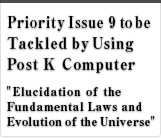Purpose and significance
Elucidating the ultimate laws of physics at a microscopic level will lead to an understanding of the beginning of the universe. The discovery of the Higgs boson confirmed the Standard Model of particle physics below a certain energy scale, ~ tera electron volts (TeV). The Standard Model is however incomplete as an ultimate law, as it does not contain the dark matter in it.
We plan to perform large-scale simulations of lattice quantum chromodynamics (QCD) in order to calculate the physical quantities needed to interpret the experimental results obtained at large particle accelerators such as SuperKEKB and J-PARC.
By precisely testing the Standard Model, we aim to find indications of a more fundamental theory behind it. This project also focuses on a study of the phase transition occurred in the early universe and a numerical study of superstring theory.
Member
Chief
Hashimoto Shoji: Professor, KEK
Particle Physics Phenomenology
Kaneko Takashi: Lecturer, KEK
Hashimoto Shoji: Professor, KEK
Matsufuru Hideo: Assistant Professor, KEK
Brian Colquhoun: Researcher, KEK
Nakayama Katsumasa: Graduate School of Science, Nagoya University / KEK
Onogi Tetsuya: Professor, Graduate School of Science, Osaka University
Fukaya Hidenori: Assistant Professor, Graduate School of Science, Osaka University
Ishikawa Ken-ichi: Associate Professor, Graduate School of Science, Hiroshima University
Izubuchi Taku: Group Leader, RIKEN BNL Research Center
Tomii Masaaki: Postdoctoral Research Scientist, Department of Physics, Columbia University
QCD Phase Transition
Aoki Yasumichi: Associate Professor, KEK / RIKEN BNL Research Center
Hashimoto Shoji: Professor, KEK
Suzuki Kei: Researcher, KEK
Guido Cossu Senior Researcher, School of Physics and Astronomy, The University of Edinburgh
Fukaya Hidenori: Assistant Professor, Graduate School of Science, Osaka University
Superstring Theory
Nishimura Jun: Associate Professor, KEK
Kaneko Takashi: Lecturer, KEK
Ito Yuta: Researcher, KEK
Aoki Toshihiro: School of High Energy Accelerator Science, The Graduate University for Advanced Studies
Tsuchiya Asato: Associate Professor, Graduate School of Integrated Science and Technology, Shizuoka University
Matsuura So: Associate Professor, Faculty of Business and Commerce, Keio University
Azuma Takehiro: Associate Professor, Faculty of Science and Engineering, Setsunan University
Hanada Masanori: Associate Professor, Yukawa Institute for Theoretical Physics, Kyoto University
Ishiki Goro: Assistant Professor, Faculty of Pure and Applied Sciences, University of Tsukuba
Kadoh Daisuke: Assistant Professor, Research and Education Center for Natural Sciences, Keio University
Sugino Fumihiko: Researcher, Institute for Basic Science, Korea
Kanamori Issaku: Researcher, Graduate School of Science, Hiroshima University
Shimazaki Shinji: Researcher, Research and Education Center for Natural Sciences, Keio University
Future outlook: 10 years later and beyond
- We will be able to precisely determine the hadronic form factors needed to analyze the data from SuperKEKB.
- We will be able to quantitatively elucidate the phase transition that occurred in the process of the Big Bang.
- We will be able to precisely verify the gauge/gravity correspondence, which is an important prediction of superstring theory.
- We will establish an efficient methodology that incorporates the effects of quantum electrodynamics (QED), so that we can calculate the density fluctuations in the early universe, for direct comparison with observational data for cosmic background radiation.





























